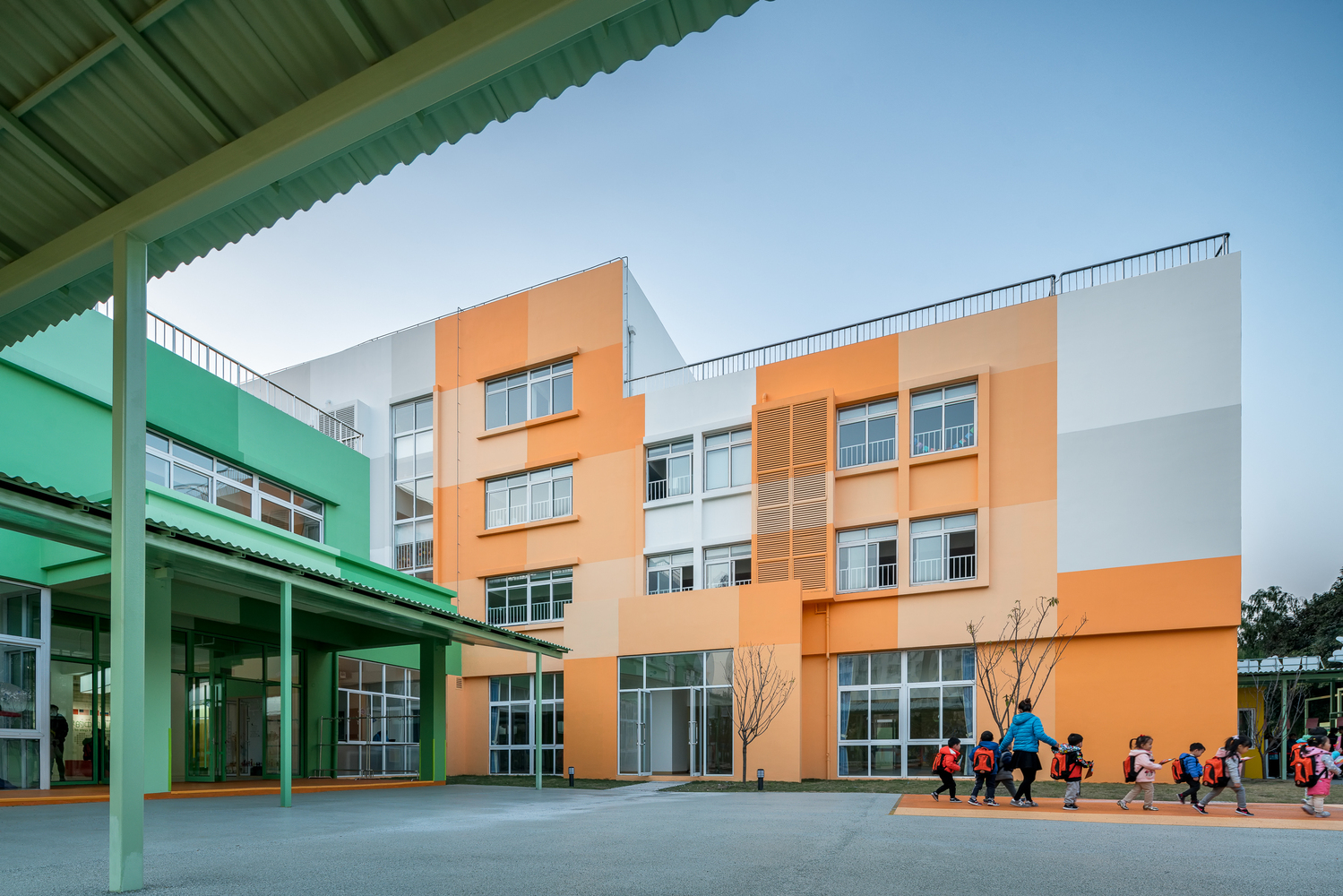House NI 1
2018-02-20 02:00
Courtesy of 1-1 Architect
1-1建筑师提供


架构师提供的文本描述。该地块是位于名古屋城附近的城市化控制区的住宅区,开发商的开发进展迅速。客户是在退休年龄之前结婚的一对夫妇,他的母亲在那里住了很多年,而业主当时居住的50年的木屋就建在工地上。他们的要求是每个私人房间和一个大面积的面积超过目前的情况。
Text description provided by the architects. The site is a residential area located in the urbanization control area near Nagoya city, development by developers is rapidly progressing around. The clients are a married couple just before the retirement age and his mother who lived there for many years, and the 50 - year - old wooden house where the owner lives at the time was built on the site. The requirements from them were each private rooms and a large floor area beyond the current situation.
Courtesy of 1-1 Architect
1-1建筑师提供


起初,这是一个重建的要求,但当我们调查现有的房屋时,我们感觉到了一种不相容的感觉。当我们观察现存房屋的天花板时,那里有一片漆黑的大空间,还有一种安静的细梁结构,这在现代日本是我们最近看不到的。与一楼的居住空间相比,我们头顶上阴暗而体积大的封闭空间是不平衡和奇怪的。有商业和迅速发展周围的网站和价值的东西已经存在了许多年。改变这个城镇的景观并不是件坏事,但我们提出了一种解决方案,它能抵抗城镇的废弃和建设,而不仅仅是随着长期存在的EPROT的最大化而离开或更新。
Initially it was a request for rebuilding, but we felt a sense of incompatibility when investigating existing houses. When we looked into the ceiling of existing house, there was a dark and large space spreading there, and there was a quiet existence of fine beams structure that we can not be seen recently in modern Japan. Compared to the living space on the first floor, the closed space with dark and large volumes above our head were unbalanced and strange. There are commercial and rapid development occurring around the site and the value of what has been there for many years. It is not a bad thing to change the landscape of the town, but we present one solution that resists the scrap and build of the town, not just leaving or updating with the maximization of esprit that was there for a long time.


具体来说,我们把一楼与天花板空间隔开的天花板表面视为“边界”,接管由一楼、天花板和边界线组成的结构,作为这座房子的框架,并考虑在这三者之间建立新的关系,以改变各自的制作方式。首先,在部分拆卸后,在现有的柱子之间插入新的梁,只留下现有平房的木架。在结构上,利用这种新的边界,可以缩短既有柱的屈曲长度和风压,同时还可以起到抗震加固的作用。
Specifically, we regard the ceiling surface separating the first floor from the ceiling space as 'boundary', take over the structure consisting of the first floor, the ceiling space and the boundary as the framework of this house and we think about creating a new relationship between the three for changing the way of making each. First, we make new surface to insert new beams between the existing pillars for new boundary after partial disassembly leaving only the wooden frame of existing flat house. Structurally, we can shorten the length of the buckling length of the existing column and the wind pressure by creating a horizontal surface with this new boundary, and at the same time it’s the function of earthquake resistance reinforcement.
Courtesy of 1-1 Architect
1-1建筑师提供


天花板空间中的边界(地板)是由边界(地板)与现有屋面/梁结构之间的关系产生的。屋面和梁的结构保持原有的高度,但由于新的边界(地板)的设置,它变成了一个可触及的手,它的感觉就像一个隔断和家具。现有的结构材料扩大了这一意义,不仅仅是屋顶和横梁。天花板上没有墙,我们在梁旁规划了一个太空小组。没有具体的房间,可以灵活更换,以满足要求的楼面面积,扩大一楼不宜居住的空间,如爱好、亲朋好友的邀请、储存等,以延长一楼不适合的生活。此外,通过使墙壁都打开与屋顶的高度隔壁的房子,提供光和风从外面到一楼,同时保持隐私。另一方面,从内部看,以天花板的高度向城镇开放,过去封闭的空间与城镇之间形成了适度的距离。
Boundary (floor) in the ceiling space Ceiling space is created by the relationship between the boundary (floor) and the existing roof / beam structure. The roof and the beam structure remain the existing height, but due to the setting of a new boundary (floor), it becomes a reachable hand, and it is felt like a partition and furniture. Existing structural materials extend the meaning beyond mere roofs and beams. There were no walls in the ceiling space, and we planned a space group by the beam. There is no specific room there, it is possible to change flexibly to satisfy the requested floor area, expansion of living which can not fit on the first floor such as hobbies, invitations of friends and relatives, storage to extend the life that can not fit on the first floor. In addition, by making the walls all open with the height of the roof next house, delivering light and wind from the outside to the first floor while maintaining privacy. On the other hand, from the inside, by opening to the town with the height of the ceiling, the space that was closed in the past creates a moderate distance with the town.
Courtesy of 1-1 Architect
1-1建筑师提供


在一楼的边界(天花板),有私人房间,根据客户的要求保持隐私。每个房间都设置了墙壁,以覆盖现有的支柱,并满足要求的功能。由于仔细观察了室内与外部的联系、隐私、通风、日光,在每个房间的边界(天花板)上规划了不同尺寸的开口,并对一楼的居住环境进行了补偿。
Boundary (ceiling) at the first floor On the first floor, there are private rooms with privacy kept as requested by the client. Each room set up walls to cover the existing pillars and satisfied the requested function. Due to careful observation about connection of inside and outside, privacy, ventilation, daylight, openings of different sizes are planed on the boundary (ceiling) of each room, and the living environment of the first floor is compensated by them.
Courtesy of 1-1 Architect
1-1建筑师提供


在这个项目中,我们命名为“边界”,这是存在的,以及最初,但它只被认为是表面的天花板。通过这样做,我们试图赋予隐藏在过去的天花板空间新的含义。在新设置的边界下,天花板空间和一楼的房间是相互补偿的。此外,城镇中出现的天花板空间不仅改变了房子的内部,而且改变了与街道不快的关系。
In this project we named 'boundary' which existed there as well as originally, but which was only recognized as the surface of the ceiling. By doing so, we try to give the new meaning to the ceiling space hidden behind in the past. With the newly set boundary, the ceiling space and the rooms on the first floor are mutually compensated. Also, the ceiling space that appears in the town not only changes the interior of the house, but also changes the relationship which is not rapid to the streets.




































.jpg)





















.jpg)

Architects 1-1 Architect
Location Chiryu, Japan
Team Yuki Kamiya, Shoichi Ishikawa
Area 454.0 m2
Project Year 2017
Category Houses
Manufacturers Loading...
























